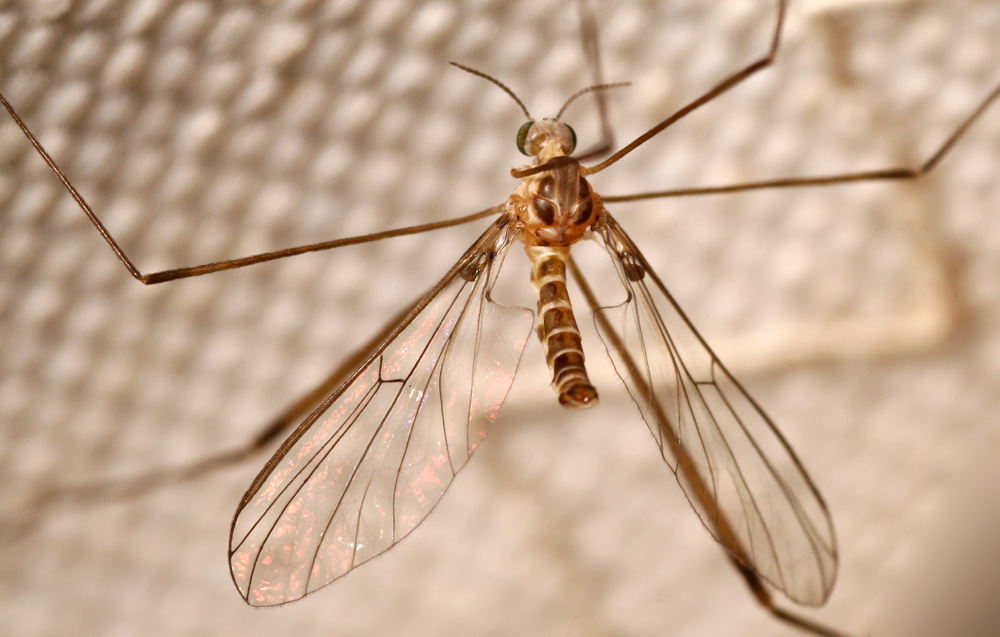Blephariceridae
Blepharicera fasciata
The Lidmücken ( Blephariceridae ), also called network midges, are a family of two-winged flies (Diptera ) and belong to the gnats ( Nematocera ).
Features
The animals are about the size of mosquito, leggy and have very little hair. The compound eyes are often divided into two parts by a ridge into an upper and a lower portion. The upper portion consists of large facets, the lower of small. The converted to a Stechsaugrüssel mouthparts are very well trained. Note the marked by a folding network front wings, the hind wings are like all Diptera to halteres ( halteres ) converted.
Way of life
The males of the Lidmücken are nectar sucker, the females are able to feed in this way. However, this attack far more often weichhäutige, small insects and suck them out. In vertebrates and man the Lidmücken not suck and they do not sting. In some species the males swarm formation occurs by which the females are attracted. Copulation and oviposition takes place in the summer, the eggs are laid in strongly flowing streams with very cold water and stuck there near the water surface to stones.
The larvae hatch in the streams. They are extremely well adapted to life in strong flowing waters. The head and chest are fused with the first Abdominalabschnitt to a segment, followed by five individual segments and the last three abdominal segments are merged again. The body is very flat and wide and slightly arched dorsally. On underside of the body are located one behind the other six suction cups, which are formed from the outer skin ( cuticle ). With these rather complicated structures built, the larvae can hold even in very strong current through a vacuum forming on the stones. The liability is increased by micro- hairs on the suction surface. The movement is effected by a detachment of the suction cups after the other or by the fact that only the front and rear suction cups are released. Even with the molt can not be washed away the larvae, as the newly created suction cups are immediately viable.
The respiration of the larvae takes place from the second to the fourth and final larval stage through tracheal gills, before by pure skin breathing. The larvae are nursery eaters who graze the nursery of stones, especially diatoms with pine trees. Thus, they do not drift away after scraping, the mosquito larvae have a strong pubescence, which retains the food in the mouth area.
For pupation the larvae attach to rocks also determined with the front end, against the current. The adhesion probably occurs by a secretion from the three penultimate Tracheenöffnungen ( spiracles ). The pupation always takes place in fairly shallow water. The respiration of the doll is made by lamellar structures ( spiracular gills ) on which keep air bubbles to form a plastron. These structures also allow to breathe atmospheric oxygen and act accordingly when the stone falls dry. The finished insect slips under water and is spread with the front legs out of the water.
System
Worldwide there are about 300 species Lidmücken known, of which seven species occur also in Germany. In Europe, 42 species are endemic.
- Apistomyia aphrodite Zwick, 1978
- Apistomyia ariadne Zwick, 1978
- Apistomyia elegans Bigot, 1862
- Fasciata fasciata Blepharicera ( Westwood, 1842)
- Blepharicera fasciata gynops (Zwick, 1970)
- Blepharicera fasciata ( Westwood, 1842)
- Dioptopsis djordjevici ( Komárek, 1932)
- Dioptopsis Sardou Zwick, 1968
- Dioptopsis vernus Giudicelli, 1963
- Liponeura Angelieri Giudicelli & Lavandier, 1975
- Liponeura bezzii Bischoff, 1925
- Liponeura bisch official Edwards, 1928
- Liponeura Buresi Komárek & Vimmer, 1934
- Liponeura cinerascens jugoslavica Komárek & Vimmer, 1934
- Liponeura cinerascens minor Bischoff, 1922
- Liponeura cordata Vimmer, 1916
- Liponeura cortensis Giudicelli, 1963
- Liponeura cretica Zwick, 1974
- Liponeura cypria Zwick, 1978
- Liponeura decampsi Giudicelli & Lavandier, 1975
- Liponeura deceptiva Vaillant, 1968
- Liponeura deceptrix Zwick, 1978
- Liponeura decipiens Bezzi, 1913
- Liponeura discophora Zwick, 1980
- Liponeura edwardsi Bischoff, 1930
- Liponeura edwardsiana Mannheims, 1954
- Liponeura gelaiana Giudicelli & Lavandier, 1975
- Liponeura hispanica Zwick, 1991
- Liponeura isabellae Zwick, 1991
- Liponeura itala Zwick, 1978
- Liponeura komareki Vimmer, 1916
- Liponeura limomi Zwick, 1980
- Liponeura malickyi Zwick, 1974
- Liponeura mater Zwick, 1982
- Liponeura nevadensis Zwick, 1978
- Liponeura paradecipiens Zwick, 1980
- Liponeura vimmeri Mannheims, 1954









